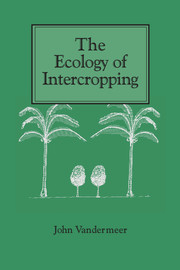Book contents
- Frontmatter
- Contents
- Preface
- 1 Introduction: intercrops and ecology
- 2 The measurement of intercrop performance
- 3 The competitive production principle
- 4 Facilitation
- 5 Mechanisms of the competitive production principle
- 6 The environments modified to produce facilitation
- 7 Special problems in intercrops involving perennials
- 8 Weeds and intercrops
- 9 Variability and intercrops
- 10 Planning intercrops – a phenomenological approach
- 11 Planning intercrops – a mechanistic approach
- 12 Critical research directions for the future
- References
- Author index
- Subject index
8 - Weeds and intercrops
Published online by Cambridge University Press: 05 August 2012
- Frontmatter
- Contents
- Preface
- 1 Introduction: intercrops and ecology
- 2 The measurement of intercrop performance
- 3 The competitive production principle
- 4 Facilitation
- 5 Mechanisms of the competitive production principle
- 6 The environments modified to produce facilitation
- 7 Special problems in intercrops involving perennials
- 8 Weeds and intercrops
- 9 Variability and intercrops
- 10 Planning intercrops – a phenomenological approach
- 11 Planning intercrops – a mechanistic approach
- 12 Critical research directions for the future
- References
- Author index
- Subject index
Summary
Weed control is often cited as one of the benefits of intercropping (Moody, 1980; Shetty & Rao, 1979; Unamma et al., 1986; Robinson & Dunham, 1954; Ibgozurike, 1971; Liebman, 1986). The presumed mode of action is that one crop, through competition with the weed, provides an environment of reduced weed biomass for the other crop. An apparent example is presented in Figure 8.1, in which a luxuriant growth of Amaranthus sp. in corn, is dramatically suppressed by a secondary crop of beans. In effect, the beans seem to have been able to replace the Amaranthus completely, and either provide a source of valuable yield, or compete less with the corn than the Amaranthus does.
Perhaps the best-known example is the use of ‘cover crops’, between rows of a monoculture. Liebman (1986) reviewed nine studies involving 23 crop–cover-crop combinations. Of the 23 cases, all but three showed a significant weed suppressive effect.
While the literature on cover crops is impressive, and suggests considerable advantage is to be gained in weed control, the literature on combinations of two crops is less extensive and more equivocal. For example, Ayeni et al. (1984), working in Nigeria, found that a maize–cowpea intercrop failed to significantly suppress weeds in the early cropping season but had a significant effect in the late cropping season. Unamma & Ene (1983) failed to find weed suppression in a cassava–maize system in Nigeria, whereas Soria et al. (1975) found this combination successfully suppressed weeds in Costa Rica.
- Type
- Chapter
- Information
- The Ecology of Intercropping , pp. 127 - 140Publisher: Cambridge University PressPrint publication year: 1989

